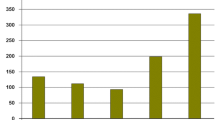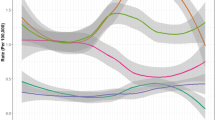Abstract
Accidents involving poisonous animals in southern Santa Catarina State, Brazil, from 1994 to 2005 were evaluated with the aim of verifying their frequency through the analysis of 2,625 victim’s reports involving poisonous animals from the SINAN (System of Injury Notification Information) files of the Municipal Health Secretary of the AMESC and AMREC microregions, formed by 27 municipalities. Statistical analysis was performed using the chi-square exact test to verify similarities between the AMREC and AMESC microregions, where p values ≤0.05 were considered significant. The results demonstrated that: 52.95% (n = 1,390) of occurrences involved spiders, 18.13% (n = 476) snakes, 5.00% (n = 131) bees, 2.29% (n = 60) caterpillars, 1.41% (n = 37) scorpions, 5.45% (n = 143) other animals and 14.78% (n = 388) unknown. The anatomic region that suffered the most bites was the feet 16.11% (n = 444). Accidents were more frequent in men 54.64% (n = 1.437) than in women 45.25% (n = 1,188). In only 1.18% (n = 31) of cases did recovery present sequelae. The months presenting the highest number of recorded cases were October through March, spring and summer in Brazil. The high frequency of victim recuperation suggests that the public health system is efficient, and the low frequency of recovered victims with sequelae also suggests that this system is fast and well-adjusted. However, there may have been deficiencies in the epidemiologic information system.



Similar content being viewed by others
References
Albuquerque HN, Fernandes A, Albuquerque ICS (2005) Snakebites in Paraíba, Brazil. J Venom Anim Toxins incl Trop Dis 11:242–251
Azevedo-Marques MM (1994) Diagnóstico e condutas nos acidentes por escorpiões e abelhas. Rev Soc Bras Med Trop 27:683–688
Blaylock R (2004) Epidemiology of snakebite in Eshowe, KwaZulu-Natal, south Africa. Toxicon 43:159–166
Bortoletto ME, Bochner R (1999) Drug impact in human poisoning in Brazil. Cad S Pub 15:859–869
Brasil (2001) Manual de diagnóstico e tratamento por animai peçonhentos. Ministério da Saúde-Fundação Nacional de Saúde (FUNASA), Brasília
Brasil (2005) Plano de Contingência de Vigilância em Saúde Frente a Inundações. Ministério da Saúde-Secretaria de Vigilância em Saúde (SVS/MS), Brasília
Candido DM, Lucas S (2002) Maintenance of scorpions of the genus Tityus Koch (scorpiones, buthidae), for venom obtention at Instituto Butantan, São Paulo, Brazil. J Venom Anim Toxins incl Trop Dis 10:86–94
Chowell G, Díaz-Dueñas P, Bustos-Saldaña R, Alemán Mireles A, Fet V (2006) Epidemiological and clinical characteristics of scorpionism in Colina, México (2000–2001). Toxicon 47:753–758
Dever GEA (1988) Epidemiologia e saúde ambiental. In: A Epidemiologia na administração dos Serviços de Saúde, Pioneira, São Paulo, pp 365–367
Diaz JH (2004) The global epidemiology, syndromic classification, management, and prevention of spider bites. Am J Trop Med Hyg 71:239–250
Diego-García E, Batista CVF, García-Gómez BI, Lucas S, Candido DM, Gómez-Lagunas F, Possani LD (2005) The Brazilian scorpion Tityus costatus Karsh: genes, peptides and function. Toxicon 45:273–283
EPAGRI - Empresa de Pesquisa Agropecuária e Extensão Rural de Santa Catarina S.A. (2002) ATLAS climatológico do Estado de Santa Catarina. CIRAM-Centro de Informações de Recursos Ambientais e de Hidrometeorologia de Santa Catarina. Florianópolis, SC. CD-ROM
IBGE - Instituto Brasileiro de Geografia e Estatística (2003) Atlas do censo demográfico 2000. Rio de Janeiro, pp 126
França FOS, Benvenutti LA, Fan HW (1994) Severe and fatal mas attack by “killer” bees (Africanized honey bees - Apis mellifera scutellata) in Brazil: clinic pathological studies with measurement of serum venom concentration. Q J Med 87:269–282
Ferreira Junior RS, Barraviera B (2004) Management of venomous snakebites in dogs and cats in Brazil. J Venom Toxins incl Trop Dis 10:112–132
Guarnieri MC, Pimentel DCC, Maia KC, Andrade LR, Lima PK, Vasconcelos CML, Valeça RC, Porto ML, Oliveira AE Jr (1996) Poisonous animal accidents in Pernambuco, Brazil: an epidemiological retrospective study from 1992 to 1994. Toxicon 34:324
Maciel Filho AA, Góes CD Jr, Cancio JA, Oliveira ML, Costa SS (1999) Indicadores de vigilância ambiental em saúde. Informe Epidemiológico do SUS 8:59–66
Marques da Silva E, Souza Santos R, Fischer ML, Rubio GBG (2006) Loxosceles spider bites in the state of Paraná, Brazil: 1993–2000. J Anim Toxins incl Trop Dis 12:110–123
Otero R, Gutiérrez J, Mesa MB, Duque E, Rodríguez O, Arango JL, Gómez F, Toro F, Cano F, Rodríguez LM, Caro E, Martinez J, Cornejo W, Gómez LM, Uribe FL, Cárdenas S, Núnez V, Díaz A (2002) Complications of Bothrops, Porthidium and Bothriechis snakebites in Colômbia. A clinical and epidemiological study of 39 cases attended in a university hospital. Toxicon 40:1107–1114
Paula Neto JB, Ribeiro RSP, Luz JA, Galvão M, Carvalho SMD, Haddad Junior V (2005) Clinical and epidemiological characteristics of injuries caused by venomous snakes observed at the hospital for tropical diseases of Araguaína, Tocantins State, Brazil, from 1995 to 2000. J Venom Anim Toxins incl Trop Dis 11:422–432
Pinho FMO, Oliveira ES, Faleiros F (2004) Acidente ofídico no estado de Goiás. Rev da Assoc Med Bras 50:93–96
Plowman DM, Reynolds TL, Joyce SM (1995) Poisonous snakebite in Utah. Wes J Med 163:547–551
Silva CJ, Jorge MT, Ribeiro LA (2003) Epidemiology of snakebite in a central region of Brazil. Toxicon 41:251–255
Steen CJ, Carbonaro PA, Schwartz RA (2004) Arthropods in dermatology. J Am Acad Dermatol 50:819–842
Tinoco HB, Norberg AN, Pile E, Carvalho CRP, Silva DA, Guerra-Sanches F (2005) Snake envenomations in northwest counties of the Rio de Janeiro state, Brazil. J Venom Anim Toxins incl Trop Dis 11:34–38
Torres JB, Marques MGB, Martini RK, Borges CVAB (2002) Na accident involving Tityus serrulatus and its epidemiological implications in Brazil. Rev S Pub 36:631–633
Van den Enden E, Bottieau E (2005) Envenoming by the viperid snake Eristicophis macmahonii. Toxicon 46:918–920
White RR, Weber RA (1991) Poisonous snakebite in central Texas. Ann Surg 213:466–471
World Health Organization (1981) Progress in the characterization of venoms and standardization of antivenins World Health Organ Tech Rep Ser 58:40–44
Acknowledgements
The authors would like to thank Conselho Nacional de Desenvolvimento Científico e Tecnológico (CNPq) for their financial support. The authors would also like to acknowledge the assistance of the Municipal Health Secretary of the AMESC and AMREC.
Conflict of interest statement
The present work has no actual or potential conflict of interest.
Author information
Authors and Affiliations
Corresponding author
Rights and permissions
About this article
Cite this article
Cardoso, D.C., Cristiano, M.P., dos Santos Raymundo, M. et al. Epidemiology and injuries (1994–2005) resulting from poisonous animals in southern Santa Catarina State, Brazil. J Public Health 15, 467–472 (2007). https://doi.org/10.1007/s10389-007-0095-3
Received:
Accepted:
Published:
Issue Date:
DOI: https://doi.org/10.1007/s10389-007-0095-3




